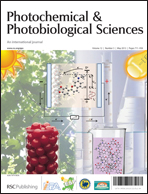The steady-state, UV–vis electronic absorption and fluorescence emission properties of a large set of 3-aryl and 3,5-diaryl substituted difluoroboron dipyrromethene dyes obtained via direct, palladium-catalyzed C–H (het)arylation of the BODIPY core are reported. The spectra display the narrow absorption and fluorescence emission bands and the generally quite small Stokes shifts characteristic of classic difluoroboron dipyrrins. As a function of the solvent, the spectral maxima are located within a very narrow wavelength range and are slightly red-shifted with increasing solvent polarizability, which is shown to be the crucial parameter influencing the wavelength position of the maxima. The extended π-conjugation in the 3,5-diaryl products always leads to bathochromically shifted absorption and emission spectra compared to those of the 3-aryl analogues. The derivative with a 3-mesityl substituent has blue-shifted spectra in comparison to its 3-phenyl substituted analogue, reflecting the diminished π-conjugation in the former due to steric strain. The nature of the meso-aryl has only a small effect on the spectral positions but affects the fluorescence quantum yield Φ. The majority of the dyes have high Φ (>0.85), except the compounds with meso-phenyl and meso-(p-nitrophenyl) substituents. Quantum-chemical calculations were performed to evaluate the differences in spectroscopic properties upon substitution of the BODIPY core and to compare them with the corresponding experimental results.

You have access to this article
 Please wait while we load your content...
Something went wrong. Try again?
Please wait while we load your content...
Something went wrong. Try again?


 Please wait while we load your content...
Please wait while we load your content...